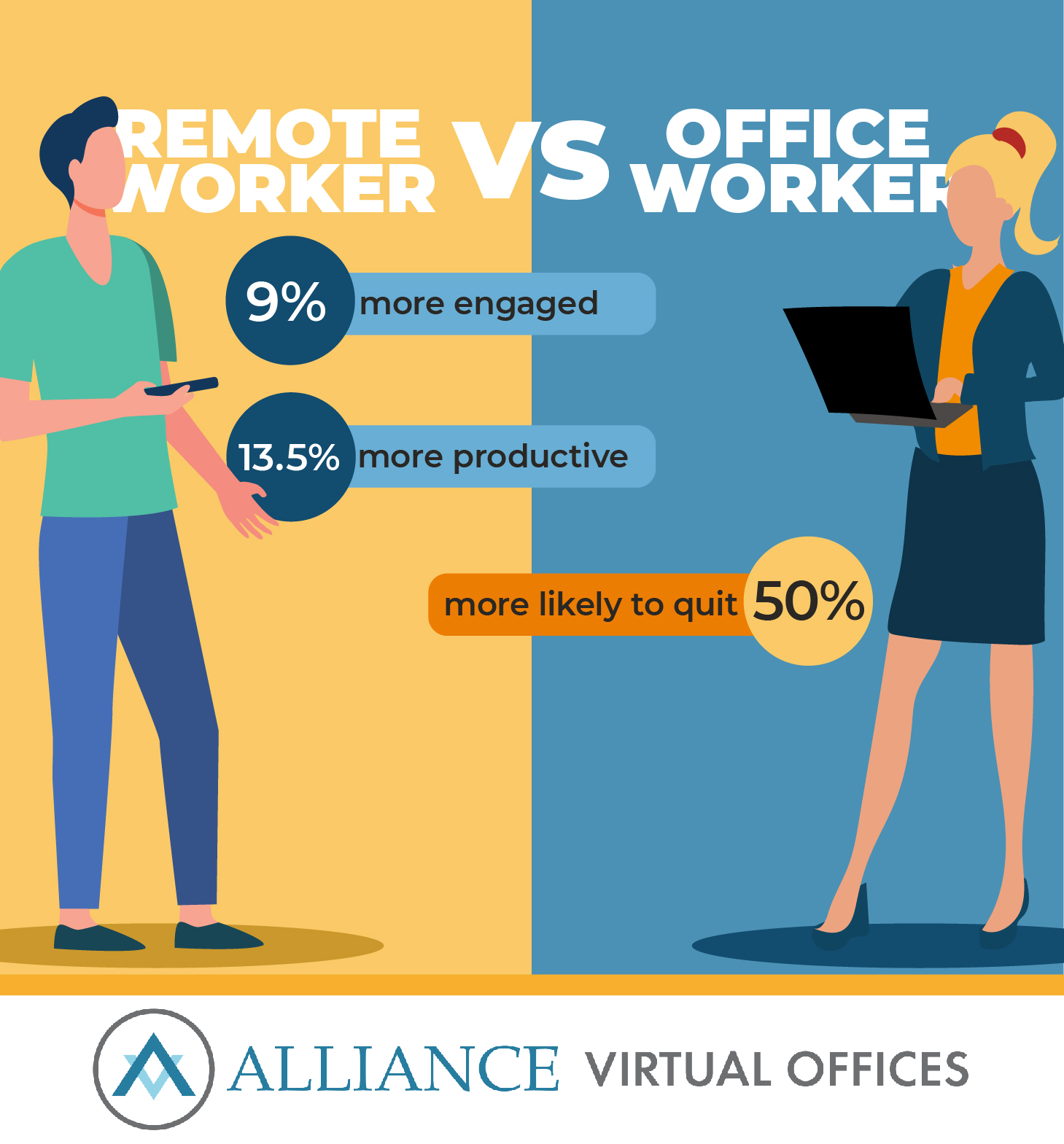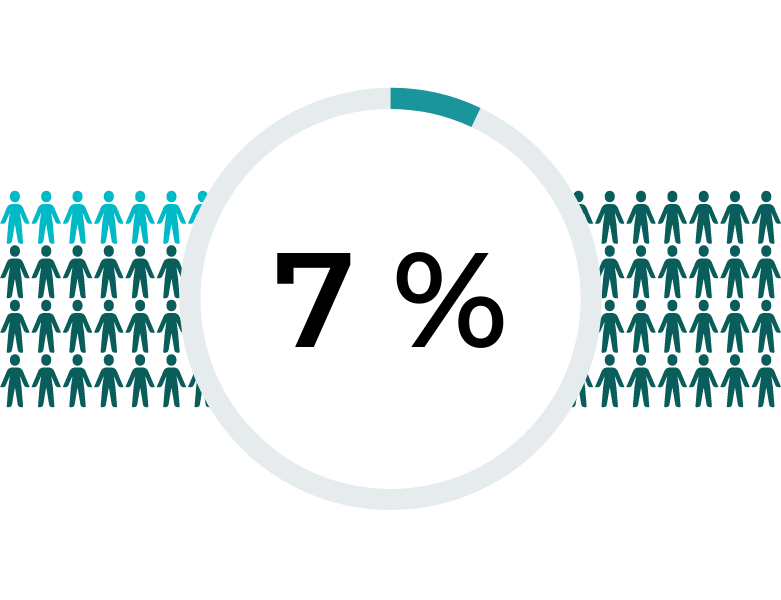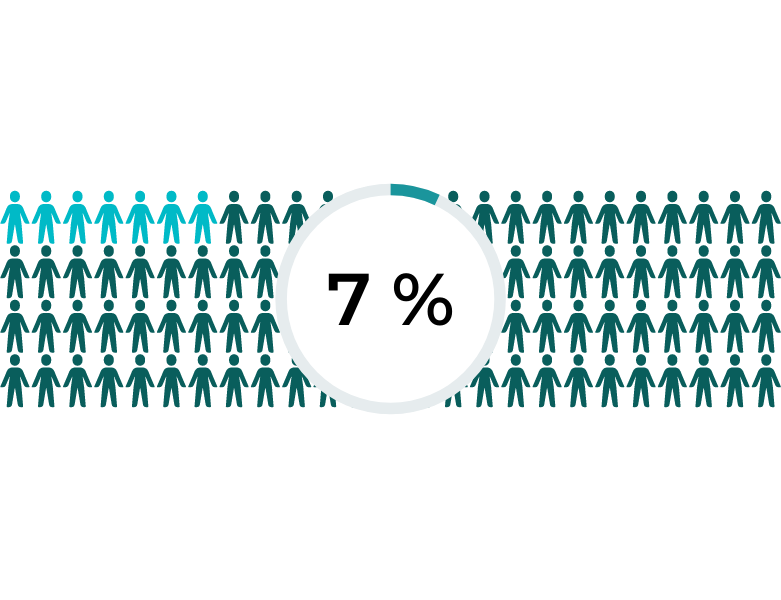- Benefits of Remote Work for Workers and Businesses
- Virtual Offices and the Hybrid Solution
- Remote Work Statistics and Graphics
Q: Will my workers be more productive if they work from home?
A: Research from Gallup claims that people who spend 60% – 80% of their time working remotely are more engaged, which correlates with higher productivity. However, full-time working from home doesn’t work for everyone.
Prior to the Covid-19 pandemic, remote work was a luxury available to a select few.
Here at Alliance Virtual Offices, we’ve always operated remotely. We have both full-time remote workers and a centralized office.
Our approach straddles two worlds: traditional office work, and remote work-from-anywhere.
We experience the pros and cons of flexible and remote work on a daily basis. And the reason we’re still doing it is because the benefits far outweigh the disadvantages.
But this article isn’t an ode to remote work.
It’s a probe into the new work mindset.
We know, and you know, that we’re in the middle of massive fast-moving change. The philosophy toward office workplaces and remote work is shifting, and our (soon to be) post-Covid world could look and feel a lot different than it did just a year ago.
People want flexibility.
They don’t necessarily want to work from home every day. But they do want the choice, trust and autonomy that comes with flexible work and the freedom to work from anywhere.
Our intention is to explore why this shift is taking place and how companies can make it work.
Remote Working Statistics and Graphics

Working from Home After Covid: Right or Wrong?
Is remote work here to stay?
Statistics suggest so. But it’s more likely to be a hybrid mix of remote and in-office work going forward.
The sudden shift to remote work during the pandemic wasn’t easy, and for some business leaders it tainted the idea of full-time remote work.
At the start of 2020, thousands of organizations dropped everything and shunted staff to makeshift offices at home, all at lightning speed.
Operational chaos ensued.
There was a frantic rush toward services like Zoom, Slack, and Microsoft Teams as companies attempted to coordinate and organize their remote workers.
Security went out the window. Privacy leaks, cyber attacks and phishing email scams soared.
Many companies struggled to adapt during those initial weeks and months, and some are still experiencing challenges.
Workers’ mental health has also suffered.
The combination of work stress, health anxiety, and financial stress — which for some people has been amplified by other factors, such as not having adequate space to work — has contributed to a specific kind of burnout brought on by the Covid-19 pandemic.
A lot of companies that dabbled in remote work over the past year are joyfully counting down the days until they can get back to the office. That safe, comfortable ‘normal’.
So is working from home bad for business?
If that were true, companies like Microsoft, Facebook, Twitter, Square, and Shopify wouldn’t allow their staff to work from home permanently.
Deutsche Bank is also considering allowing employees to work from home two days per week, while Morgan Stanley will need “much less real estate” in the future.
The list of companies transitioning to flexible work goes on.
For every company that plans a full-time return to the office, others are making remote work part of their new normal.
What’s driving this long-term shift?
Mainly it’s because companies have discovered that in some form, remote work really does work.
Many employees say they want to continue working flexibly even after the threat of Covid-19 subsides.
And for now, we are continuing to work and co-exist with Covid-19 — which means the need for remote work hasn’t gone away.
However, that doesn’t necessarily mean full-time working from home.
That approach is fraught with challenges, such as noisy kids or pets, home distractions, and insufficient workspace. Working from home can also be incredibly isolating.
Most companies will likely follow a hybridized model with elements of both remote and in-person work.
Of course, such a shift would negate the need for traditional office real estate.
If a business allows each member of staff to work remotely 20% of the time, that equates to an empty office one day per week.
Given the chance to knock 20% off your real estate bill, would you take it?
Probably.
A lot of other companies are thinking along those same lines, particularly given the ongoing uncertainty and economic shocks brought about by the current situation.
Big picture:
Our approach to office space is changing.
Companies are looking for shorter, more flexible, and less risky ways to work.
They still want (and need) the corporate HQ, or at least a version of it. But they don’t need all the square footage and expense that goes with it.
They might need less of it, or none at all.
This is why concepts like virtual offices, remote offices, and flex spaces are now becoming extremely popular across many industries.

Why Businesses Are Shifting Towards Remote Work and Virtual Offices
The pandemic triggered the world’s largest remote work experiment.
Those that tried it (even those that had negative experiences) realized they can potentially benefit from huge savings by having their employees work from home or from flex spaces.
Remote workers require less office space and facilities, which can represent significant savings for a company.
More importantly, remote work can widen the talent pool and enable companies to hire by talent and skill, rather than location.
Plus, employers stand to benefit from significant productivity gains.
A team that has the opportunity to work flexibly is more engaged.

According to a two-year study by Stanford University, remote workers are, on average, 9% more engaged and 13.5% more productive than their office-based counterparts.
They are also 50% less likely to quit.
They feel trusted, valued, and empowered, which equates to a more motivated, loyal and productive team.
It’s not surprising.
Remote work offers some pretty major advantages for employees:
- No commute, which saves time and money
- Better work life balance, due to having more time for family and hobbies
- Less exposure to illness from shared offices
- Fewer office distractions and politics
- Flexible schedule and choice over where/how to work
- A more comfortable workspace
- Quieter workspace for deep, concentrated work
And of course for the immediate term, remote work offers better levels of safety during the Covid-19 pandemic.
Longer-term, remote work can reduce an employee’s (and their employer’s) carbon footprint too.
If fewer people commute on a daily basis, it will reduce the number of cars on the road. This leads to less traffic congestion and less wear and tear on the road, and reduces the amount of greenhouse gasses released into the atmosphere.

What are the Remote Work Downsides?
As we mentioned earlier, remote work doesn’t work for everyone. It’s not a universal solution.
Partly, this comes down to planning and strategy.
Companies that were forced to work from home in 2020 suffered operational challenges because they didn’t have the knowledge or procedures to work remotely, harmoniously.
Even outside of the pandemic, remote work has its fair share of downsides, particularly when implementing a ‘pure’ remote working business model.
What are some of the struggles of working from home?
Poor leadership is another challenge. Managers that have relied on having their team all around them for years often struggle to switch to a remote work setting.
And one of the big concerns facing CEOs during the current situation is skills development.
This is particularly true for young people.
Fresh out of college or entry level jobs, young people want and need to form relationships at work. Right now, they are missing the opportunity to collaborate and learn from other experienced colleagues.
They also need to build networks that will serve them throughout their career; this is particularly important if they decide to start their own business later in life.
So while remote work has earned its place in the world of business, it’s not necessarily a complete solution.
We need human engagement.
Whether it’s for skills development, team cohesion, culture building, to onboard new people, or simply for social interaction, from time to time we need in-person ‘togetherness’.
We’re human after all, and there are only so many Zoom calls we can take.
And we hate to say it, but even commuting has its benefits.
Yes, the dreaded commute has a purpose other than getting us from one place to another.
It serves as a psychological barrier between work and home. It’s a period of time where you can release any work-related tension that has built up throughout the day, rather than take it home with you.
Anyone who works from home for any length of time can feel the erosion of the work/life boundary, and if unmanaged, it can lead to stress, fatigue, and even burnout.
So while we all hate the commute, it does have that one redeeming feature.
In lieu of that, remote workers need to find other means to release stress and create a barrier between work and home life.
Some find it in exercise. Others find it in relaxation techniques, such as meditation or yoga.
A walk in nature can do wonders for post-work relaxation, as can dog-walking or taking time out to enjoy a favourite hobby.
It’s equally important to manage your work schedule.
Setting a firm stopping point can help you switch off from work, as can creating a designated home workspace, preferably behind a door or a screen, which you can physically — and metaphorically — close at the end of your working day.

Virtual Offices and the Hybrid Solution
We know that there are both pros and cons to working from home.
Same thing applies to working in an office.
Because of this, it makes sense to adopt a ‘hybrid’ approach where employees are spending part of their time at home, and part of their time at an office.
This is exactly why many of the world’s businesses are keeping an element of remote work as part of their ongoing workplace strategy.
And that’s why virtual office space is growing in popularity.
Read more: What is a Virtual Office?
A Virtual Office provides all the essentials you’d expect from a physical office — such as a business address, somewhere to receive mail, and a place to meet clients.
The big difference is, you don’t pay for full-time office space.
Likewise, remote firms don’t need full-time office space. But like we said earlier, they do need a corporate HQ — or at least a version of it.
That’s why remote companies are well suited to a Virtual Office.
It provides the visibility of a head office and a meeting point for teams, with a prominent location for marketing and a recognized address for formal requirements like licensing and business correspondence.
The difference is, you don’t actually work there.
You only use the office space when you need it.
You can pay for a few hours of monthly usage upfront, or pay-as-you-go on an hourly or daily rate.
So when you need to pull your employees together for those important face-to-face moments — like team cohesion and personal development — you have the space you need to motivate your team.
And you can still present a professional outward image to potential clients and investors too.
Difference is, when you’re not paying for empty office space, the business makes a huge saving on workplace costs.
(When you think about it, it makes good sense to clients and investors. Wouldn’t they prefer their money to go into constructive things like product development and hiring the right people, rather than paying for office space?)
It’s not just office rental. You’ll also save on building maintenance, cleaning bills, heating and lighting, insurance, and so on.

How to Set Up Your Virtual Office
Now you know what a Virtual Office is, let’s look at how to set one up.
Hey! In the interests of disambiguation, in the following context we’re talking about the Virtual Office product, not the term ‘virtual office’ that relates to a team of remote workers.
Companies use Virtual Offices in different ways.
For some, it’s their only official office location.
These companies use it as a standalone ‘head office’ and a point of contact, while staff work from home. The Virtual Office becomes a collaboration hub for pre-arranged team gatherings and client meetings.
Other companies keep a physical head office and use Virtual Offices in addition, sometimes referred to as ‘hub and spoke’.
They might have one or more Virtual Office locations as satellite offices, providing the company with visibility in specific markets and convenient meeting points as needed.
When setting up a Virtual Office, the first step is to work with a reputable virtual office business that can provide a range of virtual office services, such as Alliance Virtual Offices.
With Alliance, you can choose a virtual office address in a prestigious building located in the nearest major city.
Remember, this address isn’t just for appearances.
It’s part of your business infrastructure. The address can be used for important processes and documentation like opening a business bank account, establishing credit, applying for business licenses, and setting up an LLC.
Read more: Using a Virtual Office to Set Up an LLC
That’s why many businesses use their Virtual Office as part of their long-term growth strategy.
After all, it’s significantly more cost-effective than a traditional office lease, which suits agile and remote organizations of all sizes.
The key is that whenever you need office space, you can bring in your team or make appointments with clients and investors anytime you like. Simply book ahead and reserve a meeting room or private office for the day (or by the hour, if it’s a flying visit).
For companies with regular office commitments, Alliance can also refer you to reputable flexible office and managed office space options.
Unlike a Virtual Office, flexible office space provides full-time access to physical office space, either in a shared environment or in your own private suite.
Terms are flexible and often short-term, commonly renewed on a rolling monthly contract, which makes a flexible office (also known as flex space, serviced office, or executive suites) much less risky and more cost-effective than traditional office leases.
Somewhere between a flexible office and a traditional lease is a managed office.
This is a fully customized office built out to your specifications, with fast move-in and delivery. Bills are all-inclusive and payable each month, which makes it easy to manage.
Flexible and managed offices are normally found in business centers with onsite staff and receptionists, who take your calls and greet visitors.
A Virtual Office solution is considered the ‘lite’ version of a flexible office, as you don’t pay for the physical workspace or day-to-day support staff.
However, you can still benefit from receptionist support, if needed.
Your Virtual Office center has onsite staff who manage your mail, sign for deliveries and greet visitors.
They can also forward your mail to an alternative address, such as your head office (if you have one) or a home address. This means you never really have to ‘check in’ at your office on a regular basis. You only use the office space when you absolutely need it.
And if you need additional help with calls and calendar management, you can add a Live Receptionist service to your Virtual Office through Alliance.
All you really need to do is pick the right Virtual Office location.
Think about the location of your employees, your clients, and your target market.
What kind of in-person events, meetings, and presentations will you need to hold?
Is it easy to reach?
Do clients ‘expect’ to find you in a downtown location or should you be more conservative in your choice of address?
Choose the right location based on proximity to your workers, but also focus on a reputable area that matches your long-term goals.
Like we said, a Virtual Office can become part of your long-term growth strategy, so take time to think about your options and decide where you want to be.

Conclusion
What does this all mean for the future?
Will the workforce stay at home, for better or worse?
Will companies that previously had an office shift to an entirely remote work setup?
Or will we gradually go back to the office, one desk at a time, as the threat of the pandemic subsides?
Only time will tell.
What we do know is that nothing is certain. After all, nobody predicted the pandemic, and no-one really knows how long it will last or when we’ll finally have it in the rearview mirror.
We can look at current trends and research and say that remote work has gained a huge amount of traction over the past year; so much so, that it is now set to become the new normal for companies all over the world.
We can also say with some certainty that, given the challenges of working from home full-time, more companies are looking at hybrid work models to provide better collaboration, and to enable more balance between work and home.
Ultimately, how we work and how work practices change over the coming months and years depends on each company’s unique circumstances.
But every organization benefits from flexibility, particularly in their workplace strategy.
With so much uncertainty still to come, it’s understandable why many organizations are downsizing and moving away from traditional long-term leases in favor of flexible and virtual solutions.
That way, companies can avoid long-term, high-risk commitments and build a more agile, cost-effective organization with greater flexibility and freedom for staff.
And that’s why we believe that remote work, in its various forms, will exist well into the future.
Are you ready for the new world of work? Share your tried-and-tested flexible work tips with us on Twitter and Facebook.















